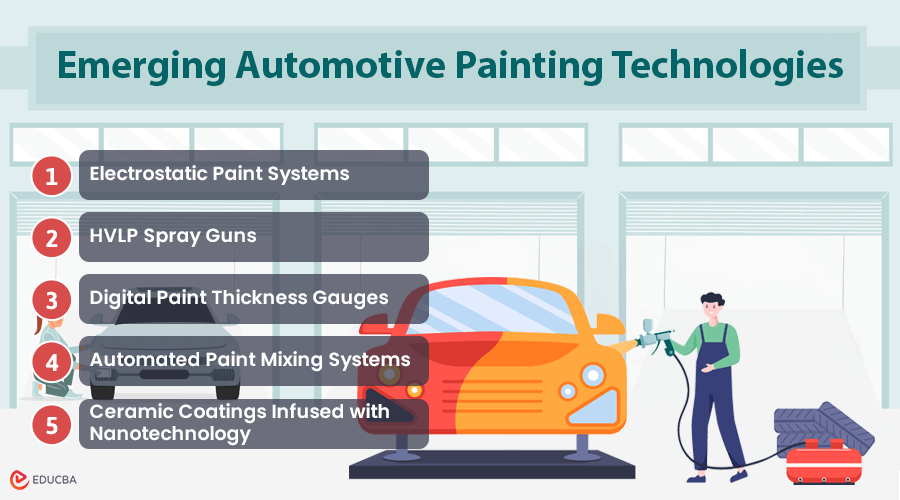
What are Automotive Painting Technologies?
Automotive painting technologies are tools and methods that technicians who do auto body repair (restoring a vehicle’s exterior after damage) use to paint and protect vehicles.
The auto body repair industry is undergoing significant changes due to new automotive painting technologies. The new tools and systems are improving the precision, efficiency, and durability of paint applications. From electrostatic systems to nanotechnology-infused coatings, these innovations are reshaping how technicians work in the automotive industry.
Whether you are already working in auto body repair or are planning on pursuing a rewarding career in vehicle collision repair (in which case, explore this auto body certification program), there are several innovative painting technologies that you need to know about.
Latest Automotive Painting Technologies
Below are some of the trending automotive painting techniques.
#1. Electrostatic Paint Systems
Electrostatic paint systems use electrically charged particles to create a more even and efficient paint application. This technology has become a game-changer for auto body repair.
Key Benefits:
- Attracts paint particles to grounded surfaces, reducing waste.
- Cuts paint usage by up to 50%.
- Provides consistent color coverage with fewer coats.
- Faster application results in quicker turnaround times.
- Eco-friendly, with less overspray and material waste.
| Comparison Parameter | Traditional Methods | Electrostatic Systems |
| Paint Usage | High | Reduced by up to 50% |
| Color Consistency | Variable | High |
| Coats Required | Multiple | Fewer |
| Environmental Impact | High overspray | Minimal overspray |
#2. HVLP Spray Guns
High-Volume, Low-Pressure (HVLP) spray guns use high air volume at low pressure, which helps minimize paint waste and ensures smooth, even finishes.
Key Benefits:
- Minimizes paint waste with low pressure, reducing overspray.
- Improves working conditions by reducing paint fog.
- Ideal for detailed and complex surface work.
- Provides better control and consistent results.
Workshops adopting this system notice improvements in quality outcomes and operational efficiency, making HVLP an attractive option for modern auto painting needs.
#3. Digital Paint Thickness Gauges
Digital paint thickness gauges have become indispensable in auto body repair, ensuring that coatings meet industry standards. These devices accurately measure the thickness of paint layers on metal surfaces, providing instant feedback.
Key Benefits:
- Technicians can avoid costly rework by maintaining consistency across panels.
- Helps technicians quickly assess if additional coats are needed or if existing ones need correction.
Results:
- Shops reduce material waste.
- Improved consistency across panels.
- Enhanced quality control.
- User-friendly interface simplifies training for staff members.
- Faster and more efficient workflow.
- Boosts confidence in achieving the desired finish every time.
#4. Automated Paint Mixing Systems
Automated paint mixing systems ensure precise color matching by automatically blending the exact proportions of base colors needed to achieve a desired shade.
Key Benefits:
- Eliminates human error
- Delivers consistently accurate results with minimal wastage.
- Technicians save time as they no longer need to manually mix paints or conduct trial-and-error tests.
- Shops can store detailed digital recipes in databases, which allows them to easily reproduce specific hues for future repairs.
As a result, automated mixing boosts both productivity and customer satisfaction by guaranteeing impeccable color alignment every single time without fail.
#5. Ceramic Coatings Infused with Nanotechnology
Nanotechnology-infused ceramic coatings offer advanced protection for vehicle surfaces. These coatings form an ultra-thin, durable layer that guards against scratches, UV rays, and environmental contaminants. Moreover, nanoparticles fill microscopic imperfections in the paintwork, creating a sleek hydrophobic barrier that repels water and dirt.
Key Benefits:
- The protective film enhances a car’s aesthetic appeal and prolongs the lifespan of its finish by reducing wear from daily exposure to elements.
- Easy application makes it popular among both professionals and DIY users.
Final Thoughts
These technologies in auto body repair will set new standards for quality, productivity, and environmental responsibility. We may also see potential future developments as follows:
- AI may further improve precision in painting systems.
- There will be more advancements in eco-friendly paints.
Recommended Articles
If you found this article on ‘Automotive Painting Technologies‘ helpful, you may also enjoy:
